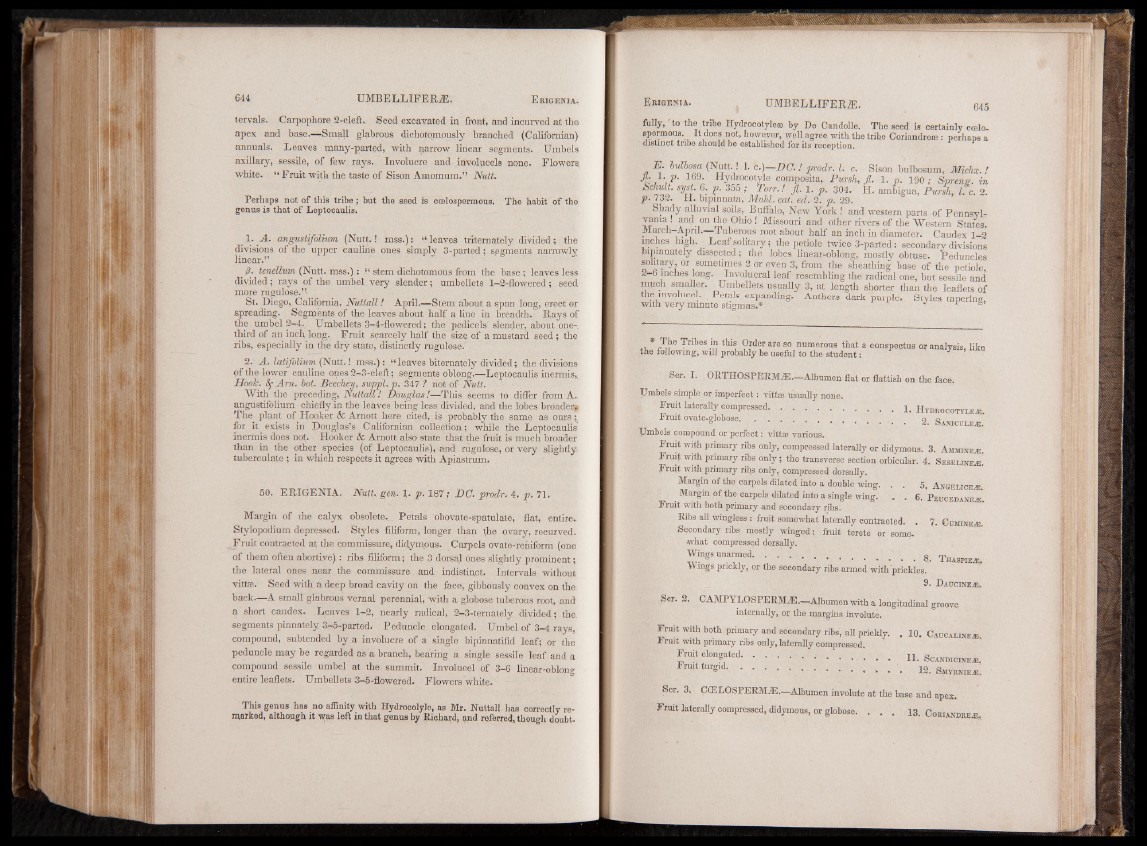
tervals. Carpophore 2-cleft. Seed excavated in front, and incurved at the
apex and base.—Small glabrous dichotomously branched (Californian)
annuals. Leaves many-parted, with rtarrow linear segments. Umbels
axillary, sessile, of few rays. Involucre and involpcels none. Flowery
white. “ Fruit with the taste of Sison Amomum.” Nutt.
Perhaps not of this tribe ; but the seed is ccelospermous. The habit of the
genus is that of Leptocaulis.
1. A. angustifolmm, (Nutt.! mss.): “ leaves triternately divided; ; the
divisions of the upper cauline ones simply 3-parted; segments narrowly
linear.”
_ p. tenellum (Nutt, mss.): “ stem dichotomous from the base ; leaves less
divided; rays of the umbel very slender; umbellets 1-2-flowered; seed
more rugulose.”’
St. Diego, California, Nuttall! April.—Stem about a span long, erect or
spreading. Segments of the leaves about half a line in breadth. Rays of
the umbel 2-4. Umbellets 3-4-flowered; the pedicels slender, about one-,
third of an inch long. Fruit scarcely half the size of a mustard seed; the
ribs, especially in the dry state, distinctly rugulose.
2. A. latifolium (Nutt.! mss.): “ leaves biternately divided; the divisions
pf the-lower cauline ones 2-3-cleft; segments oblong.—Leptocaulis inermis,,
Hook. 8f Am. hot. Beechey, suppl. p. 347 ? not of Nutt.
With the preceding, Nuttall! Douglas !■—This seems to differ from A.
angustifolium chiefly in the leaves being less divided, and the lobes broader*
The plant of Hooker & Arnott here cited, is probably the same as ours;
for it exists in Douglas’s Californian collection; while the Leptocaulis
inermis does not. Hooker & Arnott also state that the fruit is much broader
than in the other species (of Leptocaulis), and rugulose, or very slightly,
tuberculate ; in which respects it agrees with Apiastrum.
50. ERIGENIA. Nutt, gen. 1. p. 187; DC. prodr. 4. p. 71.
Margin of the calyx obsolete. Petals obovate-spatulate, flat, entire.
Stylopodium depressed. Styles filiform, longer than the ovary, recurved.
Fruit contracted at the commissure, didym.ous. Carpels ovate-reniform (one
of them often abortive): ribs filiform; the 3 dorsal ones slightly prominent;
the lateral ones near the commissure and indistinct. Intervals without
vittse. Seed with a deep broad cavity on the face, gibbously convex on the
back.—A small glabrous vernal perennial, with a globose tuberous root, and
a short caudex, Leaves 1-2, nearly radical, 2-3-ternately divided; the.
segments pinnately 3-5-parted.- Peduncle elongated. Umbel of 3-4 rays,
compound, subtended by a involucre of a single bipinnatifid leaf; or the
peduncle may be regarded as a branch, bearing a single sessile leaf and a
compound sessile umbel at the -summit. Involucel of 3-6 linear-oblong
entire leaflets. Umbellets 3-5-flowered. Flowers white.
This genus has no affinity with Hydrocolyle, as Mr. Nuttall has correctly remarked,
although it was left in that genus by Richard, and referred, though doubtfully,
' to the tribe Hydrocotylese by De Candolle. The seed is certainly ccelo.
spermous. It does not, however, well agree with the tribe Coriandrete : perhaps a
distinct tribe should be established for its reception.
E. bullosa (Nutt.! 1. c.)—DC. ! prodr. 1. c. Sison bulbosum, Michx. !
#. 1. n. 169. Hydrocotylo composita, Pursh, ft. 1. p. 190 ; Svrens. in
Sckidt. syst. 6. p. 355 ; Torr.! jl. 1. p. 304. H. ambigua, Pursh, l. c. 2.
p. 732. H. bipmnata, Muhl. eat. ed. 2. p. 29.
Shady alluvial soils,^ Buffalo, Npw York ! and western parts of Pennsyl-
vama . and on the Ohio ! Missouri and other rivers of the Western States.
March—April. Tuberous root about half an inch in diameter. Caudex 1—2
mches high. Leaf solitary; the petiole twice3-parted: secondary divisions
mpmnately dissected; the lobes linear-oblong, mostly obtuse. Peduncles
solitary, or sometimes 2 or even 3, from the sheathing base of the petiole
2-6 inches long. Involucral leaf resembling the radical one, but sessile and
much smaller. Umbellets usually 3, at length shorter than the leaflets of
the involucel. Petals expanding. Anthers dark purple. Styles taperine
with very minute stigmas.* ' • • s
., * Tke Tribes ™ thi® Order are so numerous that a conspectus or analysis, like
the following, will probably be useful to the student:
Ser. I. ORTHOSPERMiE.—Albumen flat or flatfish on the face.
Umbels simple or imperfect: vittae usually none.
Fruit laterally compressed. .............................................1. Hydrocotyleje.
Fruit ovate-globose. . . ..................................................2. Sanicule* .
fJmbels compound or perfect: vittas various.
Fruit with primary ribs only, compressed laterally or didymous. 3. Ammine^e.
Fruif with primary ribs only ; the transverse section orbicular. 4. Seseline/e.
x ruit with primary ribs only, compressed dorsally.
Margin of the carpels dilated into a double wing. . . 5, Angelice^e.
Margin of the carpels dilated into a single wing. . . 6. Peucedaneas.
Fruit with both primary and secondary ribs.
Ribs all wingless : fruit somewhat laterally contracted. . 7. Gumineas.
Secondary ribs mostly winged: fruit terete or somewhat
compressed dorsally.
Wingsunarmed. . . . . . . . . . . . . . 8. Tjuspie^
Wings prickly, or the secondary ribs armed with prickles.
9. Dagcine.*.
$er. 2. CAMPYLOSPERM.®.—Albumen with a longitudinal groove
internally, or the margins involute.
Fruit with both primary and secondary ribs, all prickly. , 10. Caucaline«.
Fruit, with nrimnrw riho rvnf-r* lot»Fruit primary ribs only, late«r«a 1l1l-y-- -c-o--m---p--r-e ssedi .
Fruit elongated........................ .................................. H . Scandigine*.
Jb ruit tur6d d. . . . . . . *. .............................. AbMYRNIEiE.
Ser. 3. CCELOSPERM2E.—Albumen involute at the base and apex.
Fruit laterally compressed, didymous, or globose. . . . 13. Coiuandrea;.